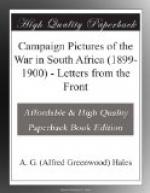If ever war was reduced to an absolute science, it was upon this occasion. On the one hand, some six thousand Boers on the defensive, armed with the handiest quick-firing rifle known to modern times, with from eight to ten guns, well supplied with food and ammunition, and backed by some of the most awful country the eye of man ever rested upon—a country which they knew as a child knows its mother’s face. On the other hand, an attacking force of 30,000 men and guns. To read the number of the opposing forces one would think the Boer task the effort of madmen, bent upon national extinction; but one glance at the country would upset those calculations entirely. Every kopje was a natural fortress, every sluit a perfect line of trenches, and every donga a nursery for death.
To attempt to go into every move made by our troops during the months of May, June, and the early parts of July would only prove wearisome to the average reader; suffice it to say that finally we got the burgher forces into the Caledon Valley. This valley is about twenty-eight miles in length, and from fourteen to fifteen miles across its widest part. Properly speaking, it was not a valley at all, but a series of valleys interspersed by great kopjes, nearly all of which presented an almost impregnable appearance. The valley had a number of outlets, which the Boers fondly believed our people to be unacquainted with. These outlets were known as “neks,” and were, without exception, terribly rough places for a hostile force to attack. Commando Nek was upon the south-east, facing towards Basutoland. This was merely a narrow pass, running up over a jagged kopje, with two greater kopjes on each side of it.




